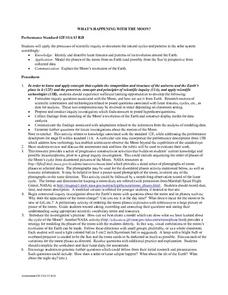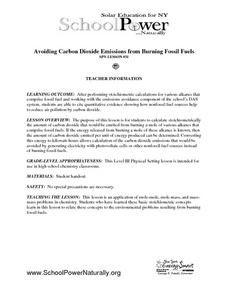Curated OER
What's Happening With the Moon?
Young scholars review the process of scientific inquiry. Using this information, they identify the patterns and cycles of the moon as it revolves around the Earth. In groups, they model the phases of the moon from the Earth and Sun's...
Curated OER
Solar System: Earth
Young scholars research Earth including what makes it suitable for life, its rotation, geological composition and gravity.
Curated OER
The Best of the Solar System (Grades 4-7)
Learners explore planetary research and become familiar with the planets and their characteristics. They compare and contrasts planets and moons.
Curated OER
Avoiding Carbon Dioxide Emissions from Burning Fossil Fuels
Chemistry and earth science meet in a lesson on carbon dioxide emissions. After reading about atmospheric problems caused by using fossil fuels, science stars balance equations for the burning of different alkanes. They compute the...
Baylor College
Needs of Plants
What better way to learn about plant life than by creating a class garden? Young botanists start with a brief discussion about radishes before planting seeds and watching them grow. To determine the importance of water,...
Curated OER
The Earth-Sun-Moon System
Third graders construct a model of the earth-sun-moon system using students as the sun, moon, and earth. They discuss ways that time is related to the movement of the earth and moon.
Curated OER
Planetary Research (Grades 9-12)
Students are introduced to planetary research and familiarize them with the planets and their features. They see that each planet has unique features. Planets have some common features and that images can be used to study the planets and...
Baylor College
What Is the Water Cycle?
Small groups place sand and ice in a covered box, place the box in the sunlight, then observe as evaporation, condensation, and precipitation occur. These models serve as miniature water cycles and demonstrations of the three phases of...
Curated OER
GROWING PLANTS UNIT
Students predict outcomes of scientific experiment,.conduct a scientific experiment with control groups, and plant seeds to observe, measure, and compare growth across groups. They gather, record, analyze, and share data with other...
Curated OER
Earth's Energy Budget - Seasonal Cycles in Net Radiative Flux
Students attempt to understand seasonal variation by viewing images of the energy received by the earth. For this weather lesson, students view images from NASA of the influx of energy from the sun and make predictions about resulting...
Curated OER
Protecting Treasures
Students explore electricity by creating an alarm. In this circuitry lesson plan, students analyze a diagram of a circuit based alarm which detects sunlight. Students utilize electrical equipment to recreate the circuit and practice...
Curated OER
Let's Make a Solar Car
Students transform a car that they have built out of K'NEX into a solar car. Students add one or two solar cells to the car to power a DC motor then connect the motor to the car and come up with a method to drive the car. This is the...
Curated OER
How do plant & animal cells make and use energy?
Students show the relationship between the need for plants to undergo photosynthesis in order to generate oxygen. They see the flaws associated with this thinking because of the lack of CO2 and H2O and lack of sufficient gravity in order...
Curated OER
A Leap of Space
Students explore how smaller systems exist within larger systems as they build a collage of their place in space! Invite the students to display their posters and talk about their systems and systems of systems.
NASA
Earth, Earth’s Moon, Mars Balloons
Very specific diameters are given for blowing up three different balloons to represent, in scale, the moon, Earth, and Mars. In groups of three, amateur astronomers explore scale measurements and distance in space.
Curated OER
As the Sun Burns
Students test commercial sunscreens or sunglasses for accuracy of their Sun Protection Factor. They devise a method for testing UV beads with a visual clues which they publish as research. They investigate occupations such as...
Curated OER
Powering a Green Earth
Learners compare and contrast renewable and nonrenewable energy. In this environmental science lesson, students discuss the importance of going green. They identify the different components in a power grid system.
Curated OER
The Communications Lab
Young scholars build and test a type of communication system called a parabolic-dish receiver. This type of system is exactly like radio telescopes, which are discussed in our song. They explain how signals are transmitted and captured...
Curated OER
Land Use
Young scholars examine ecosystems that covered Illinois 200 years ago, investigate some living and non-living components of ecosystems, identify components of prairie system, create food webs, and observe human effects on environment....
Curated OER
Planting
Students form groups to conduct an experiment. They plant seedlings to test the effects of sunlight, water and soil, on the growth of seedlings.
Curated OER
Suited for Space
A fantastic lesson on survival in outer space should excite your learners! Pupils explore the challenges that living, working, and surviving in space elicit. They focus on the spacesuit itself; how it protects astronauts, and enables...
Curated OER
Understanding the Water Cycle
Investigate the water cycle and how water moves from the land to the air and back to the land. Create a terrarium and observe the water cycle at work. Define weather terms including evaporation, condensation, and precipitation.
Messenger Education
Dangers of Radiation Exposure
Gamma radiation, which is harmful, is useful in treating cancers. In the second lesson in a series of four, young scientists take surveys and calculate their yearly exposure to ionizing radiation. Then they read about how harmful their...
Curated OER
The Life Cycle of a Star
Students investigate the life cycle of a star through research. Once research is complete, students prepare posters and present findings to class. Flash animation is included to help students visualize life cycle of star researching.

























